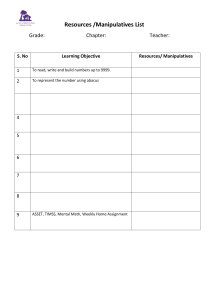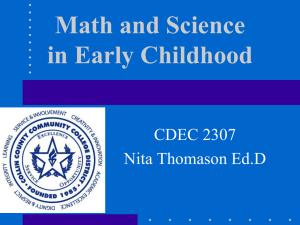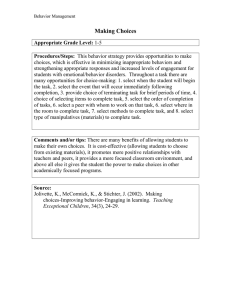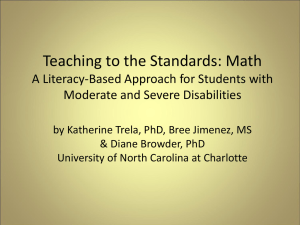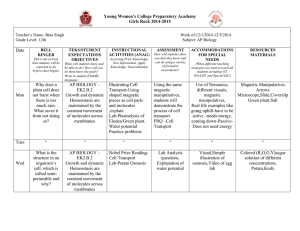10 BIG Math Ideas
advertisement
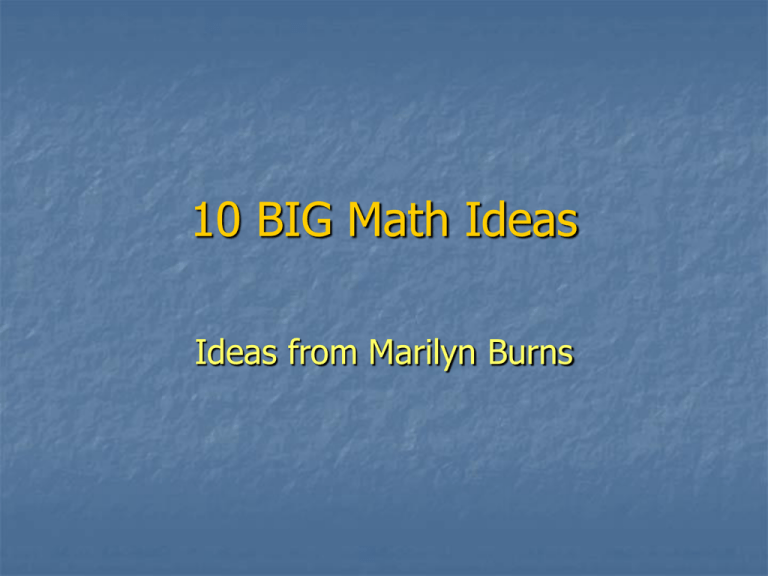
10 BIG Math Ideas Ideas from Marilyn Burns 1. Success comes from understanding To the student…Do only what makes sense to you Students need to understand that they should always try to make sense of what they do in math Encourage them to explain the purpose for what they’re doing, the logic of their procedures, and the reasonableness of their solutions 2. Have students explain their reasoning Insufficient to rely on quick, right answers to judge students’ mathematical power During math lessons, probe students’ thinking as they respond Why do you think that? Why does that make sense? Convince us. Prove it. Does anyone have a different way to think about the problem? Does anyone have another explanation? 3. Math time is a time for talk. Communication is essential for learning Interaction helps students clarify their ideas, get feedback on their thinking, and hear other points of view Students can learn from one another as well as from the teacher Make student talk a regular part of math learning 4. Make writing a part of math learning. Communication in math class should involve writing as well as talking William Zinsser (Writing to Learn, Harper, 1993) says “Writing is how we think our way into a subject and make it our own.” Writing in math class best extends from student’s talking to partners or groups. Use journal, logs, writing prompts, descriptions of their reasoning, etc. 5. Present math activities in context. Real-world contexts can give students access to otherwise abstract mathematical ideas Stimulates student interest and provides a purpose for learning Connected to examples, mathematics comes alive Use real situations, imaginary ones, student level books 6. Support learning with manipulatives. Manipulatives make abstract mathematical ideas concrete It’s important to have manipulatives for older students as well as younger ones Manipulatives give students a chance to grab onto mathematics ideas, turn them around, and view them in different ways. Can be used to introduce concepts, pose problems, and as tools to figure out solutions 7. Let your students push the curriculum. Avoid having the curriculum push the students Choose depth over breadth Avoid having your math program to be a mile wide and an inch deep “You don’t want to cover a subject; you want to uncover it.” David Dawkins quoted in Eleanor Duckworth’s book The Having of Wonderful Ideas (Teachers College Press, 1996) 7. … again … The school year passes very quickly Lots of pressures on teachers Students’ understanding is the key Doesn’t always happen to a set schedule Stay with topics that interest students Explore those topics more deeply Take the time for side investigations that can extend lessons in different directions 8. The best activities meet the needs of all the students. Look for activities that are accessible to students with different levels of interest and experience Birdwalking…Childrens’ books are often interesting to both children and adults So are cartoons… Enjoyment and learning can occur simultaneously at all levels Look for activities that allow students to seek their own level and that also lend themselves to extensions 8. … again … One example of such an activity is to challenge students to find the sum of three consecutive numbers, such as 4+5+6. Ask them to do at least five different problems and see if they can discover how the sum relates to the addends. Allowing the students to select their own numbers to add is a way for students to choose problems that are appropriate for them. Invite students to write about why they think the sum is always three times the middle number. Extension…investigate the sum of four consecutive numbers…how does the sum relate to the addends 9. Confusion is part of the process. Remember that confusion and partial understanding are natural to the learning process Don’t expect all students to learn everything at the same time Don’t expect all students to get the same message from every lesson Learning should be viewed as a long-range goal, not as a lesson objective 9. …yep, again … Students should not feel deficient, hopeless, or excluded from learning math The classroom culture should reinforce the belief that errors are opportunities for learning and should support students taking risks without fear of failure or embarrassment 10. Encourage different ways of thinking. There’s no one way to think about any math problem After students respond to a question (and have explained their thinking), ask this: Does anyone have a different idea? Keep asking until everyone who volunteers has offered her/his idea By encouraging participation, you will learn more about individual student’s thinking and send the message that there is more than one way to look at any problem or situation and that’s when the potential for delight begins … Marilyn Burns: 10 Big Math Ideas
